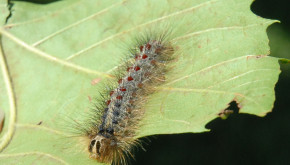
We hear a lot in the news and the forestry world about invasive species. We know we should be worried about them, but why? And just exactly what are they?
Non-native invasive species are considered a threat to forests in the U.S., because they are species of plant, fungi, insect, mammal, bird, etc., that evolved in a separate place from our ecosystem and as such the trees and plants (and animals) on our continent are unable to defend themselves against attack. They haven’t co-existed over eons and struck a balance. Sometimes our native flora and fauna can become invasive with ecosystem shifts, but most often the focus is on the non-native species.
Invasive plants can out-compete other plants by making more seed, shading, using chemicals (allelopathy), leafing out earlier and staying green longer than many of our native plants and competing with our native vegetation for vital water and nutrients. Think of plants like knapweed, kudzu and tree of heaven and how aggressive they can be. Invasive insects and diseases attack trees, killing by tunneling through the cambium and girdling the tree, introducing fungi that fills the cambium and girdles the tree, affecting photosynthetic ability at a cellular level, or feeding directly on needles and starving the tree of its ability to create photosynthate and survive. Think of the bark beetles (and there are a myriad of them), hemlock woolly adelgid, gypsy moth, chestnut blight, and new threats like emerald ash borer and Asian long-horned beetle. Invasive animals come in and disrupt ecosystems by feeding voraciously and non-specifically, decimating species that evolved without predators. Think about the cane toad in the southeast, Asian carps threatening the Great Lakes and zebra mussels.
This month’s theme is about invasive species and some of the threats to our continent’s forests. What are they? What can you do about them? And how can you react when your forest is under threat from a non-native disease, insect, or animal?

